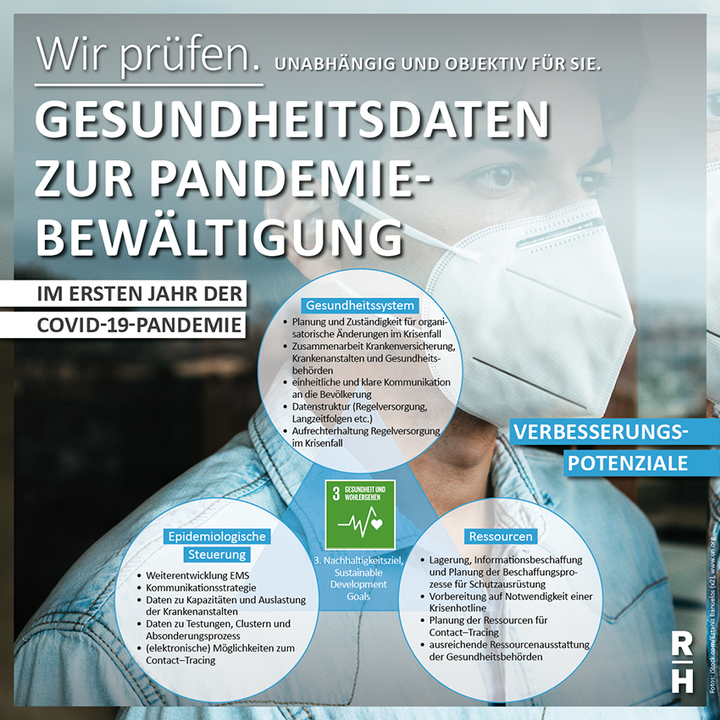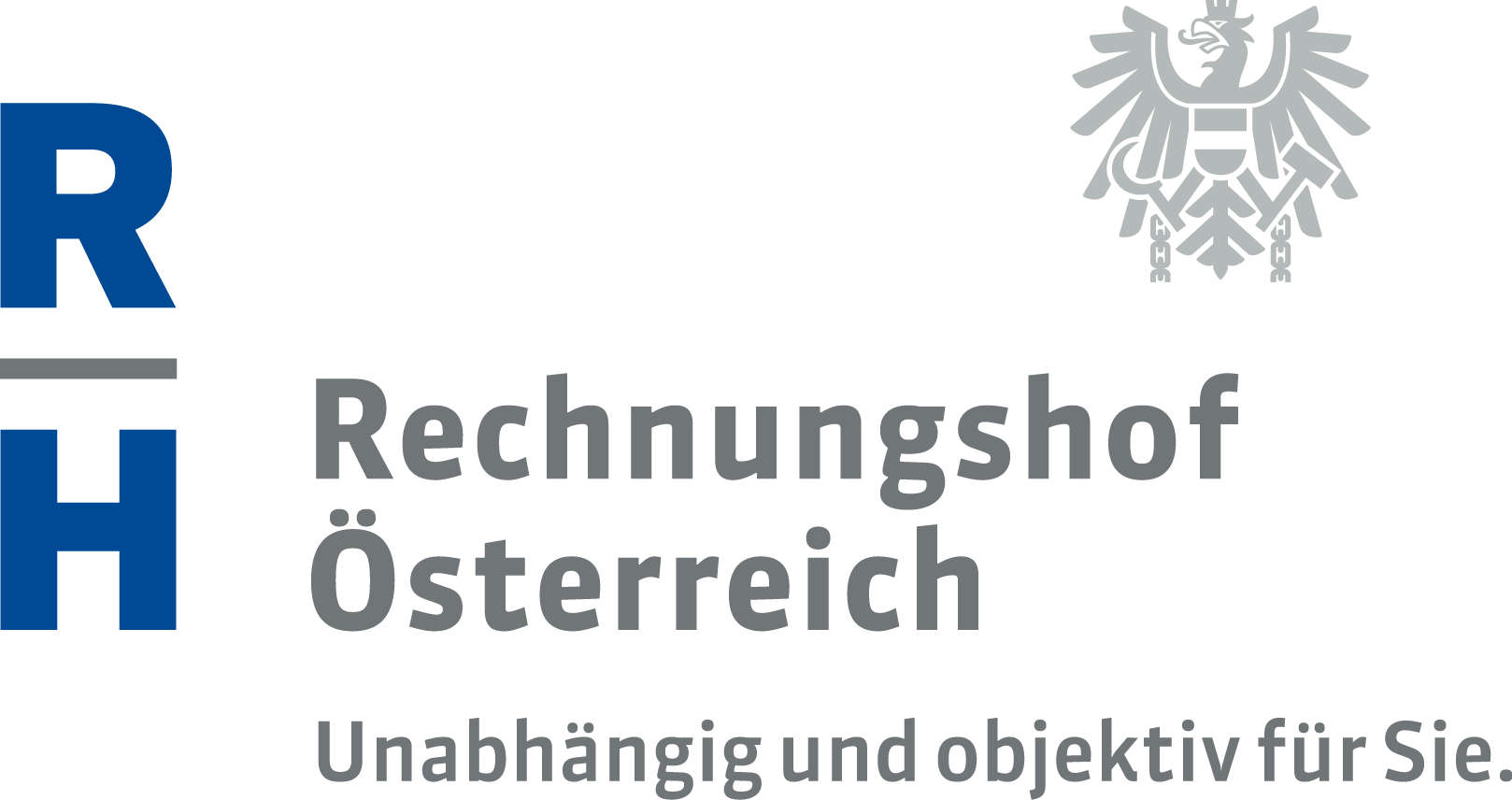Health data on the management of the pandemic: lessons for the future

The Austrian Court of Audit (ACA) wishes its report published today on "Health Data on Pandemic Management in the First Year of the COVID-19 Pandemic" to be considered as a lessons-learned report for future crisis management. In the framework of the audit, the ACA's auditors focused on the question as to how to respond to future comparable situations. The aim of the audit was to assess the availability, quality and preparation of health-related data on the incidence of infection and on epidemiological management.
An improved set of data – such as on hospital bed occupancy and regular medical care services –, the systematic use of all available data as well as uniform, quality-assured communications can make a significant contribution to pandemic management.
The audit essentially concerned the year 2020, i.e. the first year of the COVID-19 pandemic.
Sufficient information on the number of new infections
The availability of information on the incidence of infection as well as on illnesses and deaths is of critical importance for pandemic management. In essence, sufficient information was available on the number of new infections to determine lockdowns and opening measures. The inaccuracies arising from uncertainties concerning such data were smaller than those inaccuracies resulting from the unreported number of infected persons and the delayed or corrected infection reports. This is the conclusion drawn by the auditors. However, in their report they point to numerous options to improve the set of data.
Epidemiological reporting system provided a solid basis, the entry of data was inadequate
Essentially, the Federal Ministry of Health had two sources of information at its disposal: the epidemiological reporting system (ERS) applied regularly by the district administration authorities to implement the Austrian Epidemics Act (Epidemiegesetz) 1950 as well as regular reportings by the provinces to the National Crisis and Disaster Protection Management of the Federal Ministry of the Interior. With the ERS, Austria had, in an international comparison, a good starting point for recording the occurrence of infections. However, the potential was not fully exploited, especially as regards the recording and monitoring of the courses of disease and the quarantine measures.
Quarantine measures: gaps in documentation, inconsistent implementation
Despite the fact that a systematic monitoring of the quarantine measures would have been possible, the Federal Ministry of Health had failed to define any corresponding provisions. It was, for example, not mandatory to record the start of a quarantine. Overall, the data entered into the ERS was insufficient. It was therefore considerably more difficult to assess whether the measures against the spread of the disease were effective.
The identification and isolation of infected persons and the related management of contact persons were vital to mitigate the spread of COVID-19. However, the contract tracing measures could no longer be upheld consistently in November and December 2020 due to the massive increase in the number of cases. Especially in periods with a high number of infections, a considerable number of infections could either not be attributed to a cluster or they were merely identified as household clusters. A sufficiently proactive planning of human resources was not carried out in summer 2020. Furthermore, the forecast instruments that had been provided by the World Health Organisation already in May 2020 remained unused.
The telephone health counselling to be reached under the number 1450 experienced both staff-related as well as technical bottlenecks. Especially in the months of March 2020 and November 2020, many calls failed. In Upper Austria, for example, only 55,600 of 126,000 attempted calls got through in March 2020.
One virus, many provisions
The audited district authorities and the Vienna City Administration failed to implement the Epidemics Act 1950, which was to be applied throughout the country, in a uniform manner: the auditors noted substantial differences as regards the processes, the applied IT instruments and the processing of content in general. While the official notice issued by the district authority of Salzburg-Umgebung prohibited any visits, the official notice issued by the district authority of Linz-Land prohibited any unprotected contacts with persons not in the same household. The official notice issued by the Vienna City Administration contained the instruction to avoid contacts in general.
The ACA recommends to the Federal Ministry of Health to jointly analyze with the provinces the process to be applied in the case of an infection and to define an optimized process, clear reporting obligations and clear provisions for a uniform drafting of official notices. Furthermore, the ERS should be further developed by the Federal Ministry of Health.
Credibility: data inconsistencies
The different bodies of the Federal Government and the provinces published data in different formats and at different periods in time. The data also varied as concerns the level of detail and the time of analysis. According to the ACA’s point of view, this affected the citizens’ confidence in the accuracy of data. This, in turn, had a detrimental effect on the credibility of the authorities – and thereby also on the acceptance and the effectiveness of the response to the pandemic. The ACA therefore recommends to publish relevant data in a coordinated manner.
Hospital bed capacities: improved set of data only since November 2020
Hospital bed occupancy and free capacities in hospitals were calculated differently. Since 20 March 2020, the crisis unit of the National Crisis and Disaster Protection Management has collected data on a daily basis, such as on available inpatient and intensive care unit beds. However, no nationwide uniform specifications were in place as to how the relevant values were to be determined. It also remained unclear whether intensive care monitoring units had to be counted as well, which criteria had to be applied to assess the availability and whether further requirements – in particular the necessary staff for the treatment of COVID-19 patients – had to be in place. Since 30 March 2020, the Federal Ministry of Health has also collected data itself. Although, in part, the same data was collected, the analyses yielded different results. A significant improvement of the reporting system was achieved only in November 2020. Consequently, reliable data on hospital capacities was lacking even six months after the onset of the pandemic.
In order to cope with future crises and disasters, the Federal Ministry of Health should work towards creating the legal and technical foundations for the prompt transmission of uniform data on hospital occupancy. Such data, as well as diagnostic and performance data, should be interlinkable with the ERS.
Substantial decline in medical consultations and hospital stays
Especially during the first wave of the pandemic, a considerable decline in regular medical care could be observed. The available data shows that there were about 6.55 million fewer medical consultations and about 135,000 fewer screenings in 2020 than in 2019. The strongest decline in e-card consultations could be observed in the field of paediatrics and adolescent medicine with 12.3 percent, followed by dentistry and ophthalmology.
In hospitals financed via public funds, the number of hospitalization days in 2020 fell by 1.8 million compared to the preceding year – of which about 32,000 concerned intensive care units. The number of outpatient treatments fell by 3.8 million. In the whole country, cancer-related hospitalization days declined by 14 per cent. In the first wave of the pandemic, the number of colonoscopies and mammographies as measures for cancer screening decreased by more than 75 per cent in Austria. The implications of these developments were not clear. Due to a lack of routine data and a concept for accompanying research, neither the Ministry of Health nor the Austrian Health Insurance Fund (ÖGK) were able to provide information on any subsequent adverse effects on health.
Public health officers: obstacles as regards the filling of posts
Public health officers play a central role in the management of the pandemic. They are important players in the public health system, especially in crisis and disaster situations. They are entrusted with official tasks – for example as regards epidemic prevention, epidemic control and vaccination – as stipulated in the corresponding act. In its report “Public Health Service in Selected District Authorities in Upper Austria und Salzburg” published in 2018, the ACA had already highlighted that the provinces often failed to fill vacant public health officer posts. As regards this audit, the salary level as well as the lack of modernization of the profession were identified as the biggest obstacles to new appointments in the two provinces.
- pdf Datei:
- 16,474.5 KB
- Umfang:
- 252 Seiten
Report: Health Data on Pandemic Management in the First Year of the COVID-19 Pandemic (in German)
From August 2020 to February 2021, the ACA audited the use of health data as regards the response to the COVID-19 pandemic. The aim of the audit was to assess the availability, quality and preparation of health-related data on the incidence of infection and on epidemiological management. The audit also focused on data related to selected resources used for pandemic management and on the medical care provided in the outpatient sector and in hospitals during the pandemic. The audit essentially concerned the year 2020.


